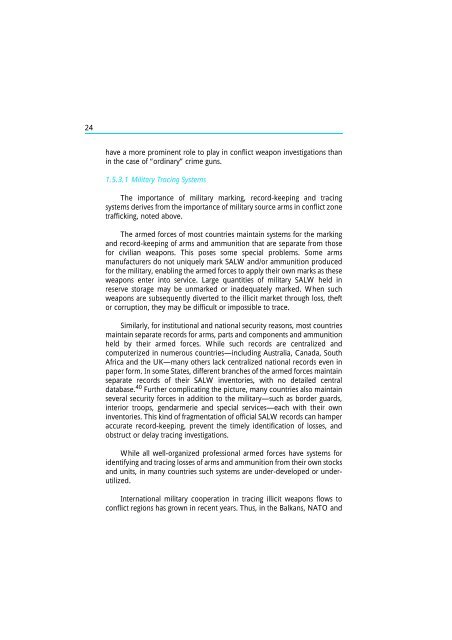The Scope and Implications of a Tracing Mechanism for Small Arms ...
The Scope and Implications of a Tracing Mechanism for Small Arms ...
The Scope and Implications of a Tracing Mechanism for Small Arms ...
You also want an ePaper? Increase the reach of your titles
YUMPU automatically turns print PDFs into web optimized ePapers that Google loves.
24<br />
have a more prominent role to play in conflict weapon investigations than<br />
in the case <strong>of</strong> “ordinary” crime guns.<br />
1.5.3.1 Military <strong>Tracing</strong> Systems<br />
<strong>The</strong> importance <strong>of</strong> military marking, record-keeping <strong>and</strong> tracing<br />
systems derives from the importance <strong>of</strong> military source arms in conflict zone<br />
trafficking, noted above.<br />
<strong>The</strong> armed <strong>for</strong>ces <strong>of</strong> most countries maintain systems <strong>for</strong> the marking<br />
<strong>and</strong> record-keeping <strong>of</strong> arms <strong>and</strong> ammunition that are separate from those<br />
<strong>for</strong> civilian weapons. This poses some special problems. Some arms<br />
manufacturers do not uniquely mark SALW <strong>and</strong>/or ammunition produced<br />
<strong>for</strong> the military, enabling the armed <strong>for</strong>ces to apply their own marks as these<br />
weapons enter into service. Large quantities <strong>of</strong> military SALW held in<br />
reserve storage may be unmarked or inadequately marked. When such<br />
weapons are subsequently diverted to the illicit market through loss, theft<br />
or corruption, they may be difficult or impossible to trace.<br />
Similarly, <strong>for</strong> institutional <strong>and</strong> national security reasons, most countries<br />
maintain separate records <strong>for</strong> arms, parts <strong>and</strong> components <strong>and</strong> ammunition<br />
held by their armed <strong>for</strong>ces. While such records are centralized <strong>and</strong><br />
computerized in numerous countries—including Australia, Canada, South<br />
Africa <strong>and</strong> the UK—many others lack centralized national records even in<br />
paper <strong>for</strong>m. In some States, different branches <strong>of</strong> the armed <strong>for</strong>ces maintain<br />
separate records <strong>of</strong> their SALW inventories, with no detailed central<br />
database. 40 Further complicating the picture, many countries also maintain<br />
several security <strong>for</strong>ces in addition to the military—such as border guards,<br />
interior troops, gendarmerie <strong>and</strong> special services—each with their own<br />
inventories. This kind <strong>of</strong> fragmentation <strong>of</strong> <strong>of</strong>ficial SALW records can hamper<br />
accurate record-keeping, prevent the timely identification <strong>of</strong> losses, <strong>and</strong><br />
obstruct or delay tracing investigations.<br />
While all well-organized pr<strong>of</strong>essional armed <strong>for</strong>ces have systems <strong>for</strong><br />
identifying <strong>and</strong> tracing losses <strong>of</strong> arms <strong>and</strong> ammunition from their own stocks<br />
<strong>and</strong> units, in many countries such systems are under-developed or underutilized.<br />
International military cooperation in tracing illicit weapons flows to<br />
conflict regions has grown in recent years. Thus, in the Balkans, NATO <strong>and</strong>
















